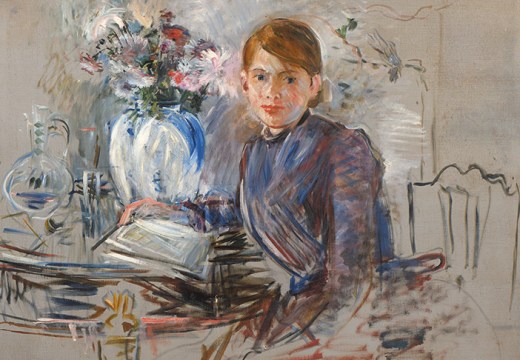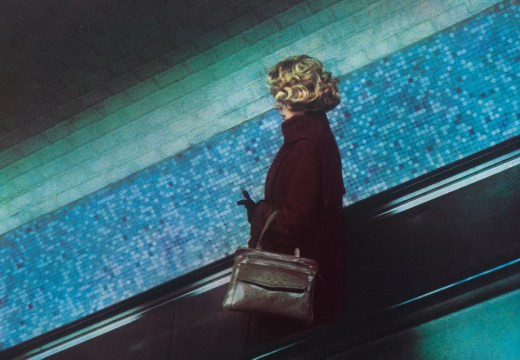From the November 2023 issue of Apollo. Preview and subscribe here.
Edgar Degas’s In a Café (The Absinthe Drinker) of 1875–76 depicts the actress Ellen Andrée sitting impassively, the pictorial space severed by levitating grey tables, while a man dressed in black sits beside her like a chaperone from the underworld. Her eyelids are slabs of heavy flesh, drooping into nothingness, closing her off from the world around her. Édouard Manet used the same model for Plum Brandy (c. 1877), painted only a year later, yet the women bear little resemblance to each other. The wall captions in ‘Manet/Degas’, now at the Metropolitan Museum of Art (and previously at the Musée d’Orsay), tell us that both pictures express ‘alienation’ and ‘isolation’, but I don’t detect those ideas or emotions in Manet’s picture. If Degas’s figure is half-alive, the shadow behind her auguring death and desolation, in Manet the same subject looks eager, open to experience and desirous of company; the whole composition is bursting with pink. Degas’s drinker is lost inside herself, whereas Manet’s seems lost, but happily so, in her environment. Her hands are thick and fleshy, keen to grasp the world. Even the plum in her brandy pops up to say hello. I’d wager that Degas’s is a closer likeness, yet you also feel a sense of the painter’s distance. Manet on the other hand approaches his subject, offering to light her cigarette.

Installation view of ‘Manet/Degas’ at the Metropolitan Museum of Art. Photo: Anna-Marie Kellen; courtesy the Met
‘Manet/Degas’ opens with a juxtaposition of self-portraits divided by a sharp, angled gap in the wall, immediately conjuring a rupture between the two great painters, inviting the viewer to look for tension, differences, contrasts. Sharing a sense of love and rivalry, their different accounts of human experience are revealed in their distinctive surfaces and compositions. In the opening gallery, which includes portraits of Manet by Degas (Manet, by contrast, never painted Degas) and by Manet of his wife, a difference in temperament is palpable. Where Degas aspires to a sense of control, clarity and refinement, Manet is agitated, restless, seeking vivacity over equilibrium. The eyes of Degas’s figures, not least in his portraits of Manet, possess the space around them. Manet’s eyes are open portals, gladly permitting everything to enter their field of vision. Degas’s eyes point like lasers: I have you now.

Repose (c. 1871), Édouard Manet. RISD Museum, Rhode Island
In Manet’s Repose (c. 1871), a portrait of Berthe Morisot, his subject’s eyes invite the room to intrude into her thoughts. Her left hand looks like a spider crawling across the sofa, more alert than her face, while her right hand is a smear of pigment, a blur, an aside. Compare this to Degas’s pastel of Berthe’s sister, Madame Théodore Gobillard (Yves Morisot) of 1869, in which the subject’s eyes look to the right with pinpoint clarity, fixed on the space beyond the frame. In the next gallery, a room called ‘At the Racecourse’, Degas’s small picture Woman with Field Glasses (c. 1877) depicts a figure against a red-umber background, staring at the viewer through binoculars, two diamond-like spots of light glinting off the lenses. She’s distant and analytical, safely hidden behind her glasses, behind the act of looking. I don’t need to feel the world, she seems to say, but see it. In Manet’s portrait of Morisot, by contrast, the figure looks receptive to all experience. The subject is almost irrelevant: the painting is a tour de force of texture and atmosphere.

Woman with Field Glasses (c. 1877), Edgar Degas. Albertina Museum, Vienna
Manet was manifestly enthralled by visual experience – the shadow under a glass, the glint of blue in a wave – which he transferred to the canvas as an idea, or as an analogue of that experience. Degas conjures a sense of control and continuity across the composition, and an overall mood – like a musical key – that gives his work greater focus and coherence. In Reading (c. 1866–73), Manet changed the left side of the picture seven years after finishing the central portrait of his wife: languid green leaves enter from the left, angled and dangling, like some new consciousness reaching into the picture, creating a surreptitious conversation with the figure’s outstretched hand, the dialogue framed by silvery passages of light filtering through translucent curtains. This belated, seemingly off-the-cuff corner of the picture shows Manet at his most virtuosic. Yet he could be awkward too, the sense of fragmentation disarming. In The ‘Kearsarge’ at Boulogne (1864), Manet depicts a sailboat as a clumsy thing, almost collaged into the sea, tilting drunkenly atop some chunky waves. Hanging nearby, Degas’s Fishing Boat at the Entrance to the Port of Dives (1869) shows a boat gently tilting to the left, its sails a hazy blend of greys and pinks, almost hovering above a soft-focus sea of pinks and greens, every hue and tone glancing from subject to background as if they were part of a single pictorial fabric. Manet’s world is often fractured, and you get the impression he was working out ideas – and entertaining himself – while he painted. Degas presents a well-wrought urn, beautiful and inviolate; Manet’s canvases burst forth with anxious revelations.
Though Degas outlived Manet by 34 years, the last gallery in the exhibition features work only by Manet. Here is Berthe Morisot in Mourning (1874) alongside a portrait of his wife, a slab of ham, a number of prints, including a portrait of Baudelaire and, by far the largest painting in the room, The Execution of Maximilian (c. 1867–68). The work was sliced into fragments, possibly by Manet himself, and sold through his dealer as snippets of the larger history painting – a small portrait of a man, a detail of his hand holding Maximilian’s, soldiers firing into nothingness, another inspecting his gun. Degas assembled the four surviving sections, Frankenstein-like, into a near-coherent composition. By resurrecting the work of his beloved rival, Degas found a way to draw from Manet’s restless energy, long after his death.
‘Manet/Degas’ is at the Metropolitan Museum of Art, New York, until 7 January 2024.
From the November 2023 issue of Apollo. Preview and subscribe here.
Unlimited access from just $16 every 3 months
Subscribe to get unlimited and exclusive access to the top art stories, interviews and exhibition reviews.














![Masterpiece [Re]discovery 2022. Photo: Ben Fisher Photography, courtesy of Masterpiece London](http://www.apollo-magazine.com/wp-content/uploads/2022/07/MPL2022_4263.jpg)
Has arts punditry become a perk for politicos?